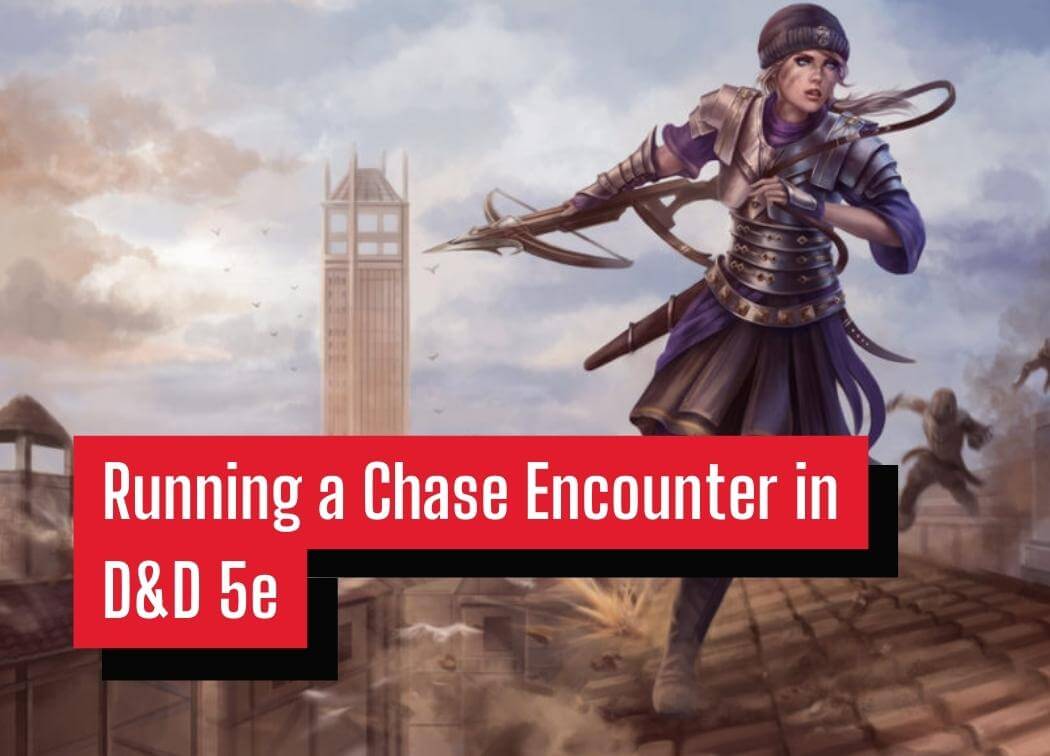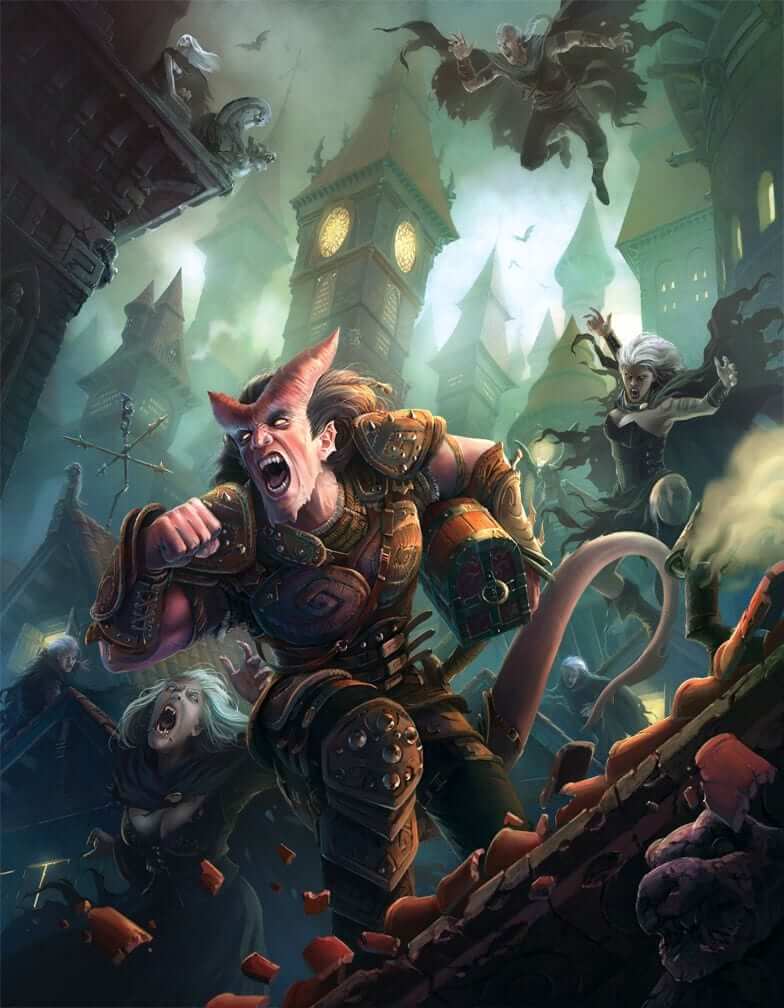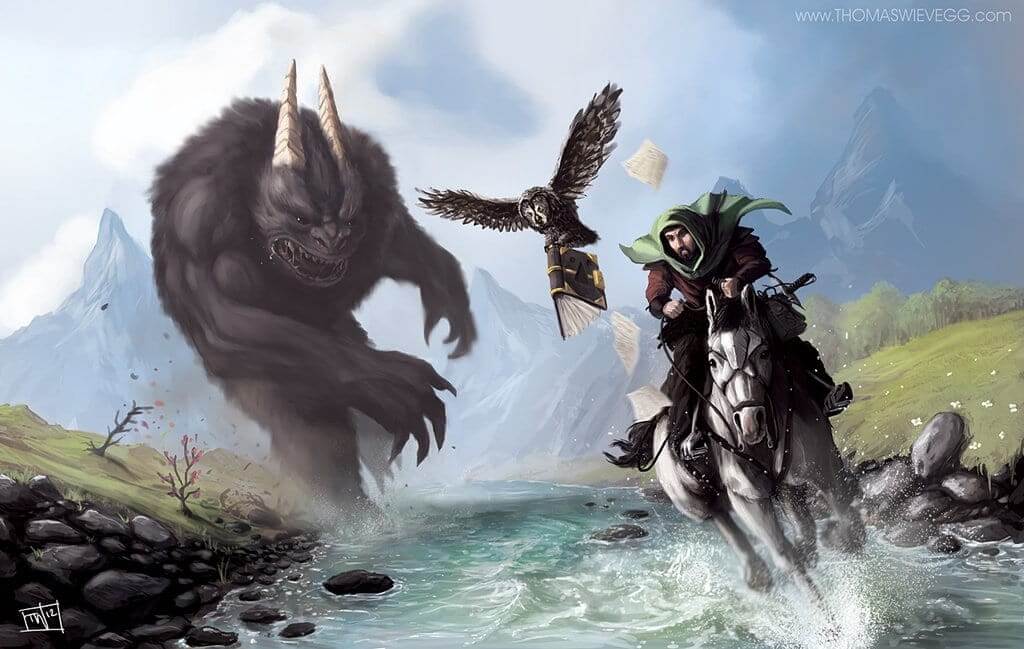Running a Chase Encounter in D&D 5e

I’ve mentioned before that an encounter doesn’t have to be a standard combat encounter. Puzzles, traps, and even high-stakes dialogue can all make for a resource-draining encounter. One type of encounter that doesn’t get a lot of love or mentions on the internet is the chase encounter. I don’t run many of them, but when I do they end up being both very intense and expose a deeper element to the plot.
The Dungeon Master’s Guide spells out the rules and mechanics of a chase encounter on pages 252-255. I’ll go over some of these, but for the most part, I don’t end up using most of them in higher-level chases. Once players start gaining access to higher-level spells and abilities a lot of the threats of a basic chase become obsolete.
I also tend to utilize theater of the mind combat over my preferred method of grid-based combat on a battle map. This is because chases will frequently get out of hand and players will think outside the confines of whatever map I’ll make. It’s easier for me to simply describe the surroundings and let the players ad-lib off of that.
Why Run a Chase Encounter?
It’s difficult to find an appropriate way to introduce encounters and conflicts in an open city. A chase is easy to justify depending on the city and how seedy the area is that the party is currently exploring. A pickpocket steals a PC’s coin purse, the party notices the big bad undercover or the party notices they are being spied on are just three ways that a chase encounter could break out.
These types of encounters may be even more prevalent in an encounter with a party full of criminals. You won’t be able to stealthily pick every pocket and the guards will try to chase after you.
I also like to use chase encounters to introduce plot information. Noticing a villain undercover or discovering a spy are both interesting plot points where the party is being chased and if they catch their quarry they’ll be able to interrogate them and gain information on their position.
The party could just as easily be discovered by an enemy that they are spying on and have to run full-speed away from the enemy base. They may be able to learn more about the number of enemies in the location or other useful information for when they return.
Initiating a Chase Encounter
Initiating a chase encounter is pretty straightforward mechanically. Everyone involved in the chase has to make an initiative roll.
However, it’s going to depend on the circumstances for the chase. If the party is noticed spying on the enemy maybe the enemy gets a head-start. The same can be said for the opposite instance.
Regardless, once the chase is on and initiative has been rolled you’ll want to describe the surrounding area to the party. Alleyways and sewers are fun places to run a chase encounter as there are so many offshoots that the quarry can run into and potentially escape. Make sure to note things like crates, barrels, and anything that can be utilized during the chase.

During the Chase Encounter
Generally, I have the quarry get a bit of a head-start on the pursuers. This gives them an extra round or two of a buffer and will extend the chase a bit. It can also give them some range from particularly troublesome spells and abilities that would typically lock them down.
Dungeon Master’s Guide Rules
There are a few simple rules in the DMG for chases. The first of which is that because a chase encounter happens so quickly there’s no reason for anyone to be going first outside of the initiative order.
Everyone is running at the same time in the same direction. Because of this by RAW there are no attacks of opportunity. This is one rule I tend to ignore due to feats like Sentinel having some great value in a chase encounter and can make a character stand out flavor-wise. I don’t think it takes much away from the encounter.
There are separate rules for making a Dash Action as well. Due to the nature of a chase being a sprint to catch a quarry you can only Dash a limited amount of times in a short window of time. A creature or PC in a chase encounter can dash 3 + Constitution modifier number of times in the encounter. After this, they have to make a DC 10 Constitution check at the end of their turn or gain 1 level of exhaustion.
I like this rule, but I rarely have any encounter go that long, however, this is a great way to ensure that the rogue won’t infinitely dash using 2 dashes per round plus their movement and reach the target in round 2. This rule also helps classes like monks which have increased movement speed shine.
Obstacles
Different buildings, items, and difficult terrain can make a basic chase encounter into a high-stakes tactical nightmare. Have the quarry jump over tables and knockdown crates. If the quarry is a spell caster throw spells like Grease and use Misty Step. Chases should not be a track meet they should be a dynamic encounter.
I mentioned before that at the higher levels chases tend to be very quick and very intense. This is due to the party and the enemy having access to these spells that help them create or avoid obstacles. I’d always be sure to have the enemy have Legendary Resistance or Counterspell available at the higher levels to make things more interesting.
Difficult terrain does not have to be a swamp full of mud or an icy street. Having to chase through a crowd of people in a major city would also be difficult terrain. It also presents the quarry a way to stealth and potentially lose the party.
Ending a Chase Encounter
There are only two ways that a chase ends. Either the pursuers give up or the quarry escapes. Another way of ending a chase encounter is if the party each has 5 levels of exhaustion from dashing. This is effectively the party giving up, but it’s due to a lack of resources rather than willpower.
The quarry can escape into the crowd or a building and avoid the party’s Perception. They could make it to their destination and lock it so the party can’t enter.
Chases are extremely binary. Either the quarry is caught or they escape. There’s little grey area or room for debate. It’s pretty refreshing in a game with so many “what ifs” and “buts”.

Difficulties with Running a Chase Encounter
The first time you ever run a chase encounter your players are going to be a bit confused. Chase encounters are a unique style of encounter compared to a usual combat or puzzle encounter. The big thing to remember is that things are constantly moving forward.
However, once the players grasp the basic mechanics they’ll be able to think outside the box and can change the tone of the encounter within a few rounds. Chases can give some infrequently used spells some time to shine. The utility-focused player in the party will also have tons of ways to shine during the encounter.
Rogues can be listed here as a difficulty. Due to their Cunning Action, they have access to a bonus action Dash in addition to a regular Dash Action. This means that they can move 3x their movement in a single round of combat. Pelor forbid you have any type of spell or ability that can increase your speed.
The limited amount of Dash actions in a chase does help combat this in that they become a sprinter rather than a marathon runner like a monk, but still. Start your quarry far away so that the party rogue can’t run up and tackle them before the chase even begins.
Conclusions
As with everything in the DMG, these are variant rules. Nothing is set-in-stone so feel free to use what you like and throw away what you don’t. As I said, I think the limited Dash Actions are great, but I don’t typically remove attacks of opportunity. This is because encounters still get a bit cumbersome when they last too long in real-time.
I usually shoot for a regular encounter lasting 3-5 rounds and this can last around 30-45 minutes with my group of 4-5 depending on the complexity of the fight. You have fewer unique actions to take with chase encounters so you do save a bit of time on each turn. I aim for around 5-8 rounds for a chase encounter. Generally, this is about 20-30 minutes of real-time and is easily digestible, and keeps the encounter feeling intense.

Thanks for this! Gives me a lot clearer idea on how *I* want to run chases. 🙂